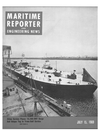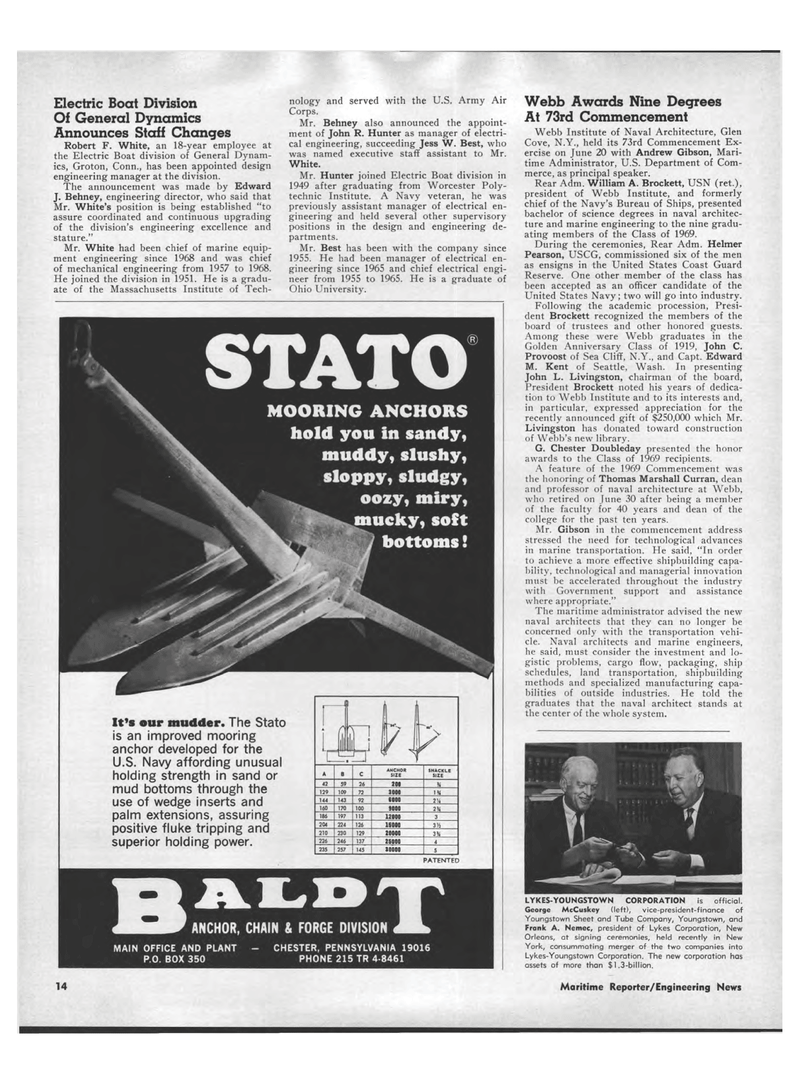
Page 12: of Maritime Reporter Magazine (July 15, 1969)
Read this page in Pdf, Flash or Html5 edition of July 15, 1969 Maritime Reporter Magazine
Electric Boat Division Of General Dynamics Announces Staff Changes Robert F. White, an 18-year employee at the Electric Boat division of General Dynam-ics, Groton, Conn., has been appointed design engineering manager at the division. The announcement was made by Edward J. Behney, engineering director, who said that Mr. White's position is being established "to assure coordinated and continuous upgrading of the division's engineering excellence and stature." Mr. White had been chief of marine equip-ment engineering since 1968 and was chief of mechanical engineering from 1957 to 1968. He joined the division in 1951. He is a gradu-ate of the Massachusetts Institute of Tech-nology and served with the U.S. Army Air Corps. Mr. Behney also announced the appoint-ment of John R. Hunter as manager of electri-cal engineering, succeeding Jess W. Best, who was named executive staff assistant to Mr. White. Mr. Hunter joined Electric Boat division in 1949 after graduating from Worcester Poly-technic Institute. A Navy veteran, he was previously assistant manager of electrical en-gineering and held several other supervisory positions in the design and engineering de-partments. Mr. Best has been with the company since 1955. He had been manager of electrical en-gineering since 1965 and chief electrical engi-neer from 1955 to 1965. He is a graduate of Ohio University. STATO MOORING ANCHORS hold you in sandy, muddy, slushy, \ sloppy, sludgy, ' oozy, miry, X f^*** mucky, soft n^ ^ l^kz -A /bottoms! It's our mudder. The Stato is an improved mooring anchor developed for the U.S. Navy affording unusual holding strength in sand or mud bottoms through the use of wedge inserts and palm extensions, assuring positive fluke tripping and superior holding power. A B c ANCHOR SIZE SHACKLE SIZE 42 59 26 200 X 129 109 72 3000 1* 144 143 92 (000 2'/, 160 170 100 9000 2X 186 197 113 12000 3 204 224 126 15000 2h 210 230 129 20000 3X 226 246 137 25000 4 235 257 145 10000 5 PATENTED ANCHOR, CHAIN & FORGE DIVISION T )N JHL MAIN OFFICE AND PLANT P.O. BOX 350 CHESTER, PENNSYLVANIA 19016 PHONE 215 TR 4-8461 Webb Awards Nine Degrees At 73rd Commencement Webb Institute of Naval Architecture, Glen Cove, N.Y., held its 73rd Commencement Ex-ercise on June 20 with Andrew Gibson, Mari-time Administrator, U.S. Department of Com-merce, as principal speaker. Rear Adm. William A. Brockett, USN (ret.), president of Webb Institute, and formerly chief of the Navy's Bureau of Ships, presented bachelor of science degrees in naval architec-ture and marine engineering to the nine gradu-ating members of the Class of 1969. During the ceremonies, Rear Adm. Helmer Pearson, USCG, commissioned six of the men as ensigns in the United States Coast Guard Reserve. One other member of the class has been accepted as an officer candidate of the United States Navy; two will go into industry. Following the academic procession, Presi-dent Brockett recognized the members of the board of trustees and other honored guests. Among these were Webb graduates in the Golden Anniversary Class of 1919, John C. Provoost of Sea Cliff, N.Y., and Capt. Edward M. Kent of Seattle, Wash. In presenting John L. Livingston, chairman of the board, President Brockett noted his years of dedica-tion to Webb Institute and to its interests and, in particular, expressed appreciation for the recently announced gift of $250,000 which Mr. Livingston has donated toward construction of Webb's new library. G. Chester Doubleday presented the honor awards to the Class of 1969 recipients. A feature of the 1969 Commencement was the honoring of Thomas Marshall Curran, dean and professor of naval architecture at Webb, who retired on June 30 after being a member of the faculty for 40 years and dean of the college for the past ten years. Mr. Gibson in the commencement address stressed the need for technological advances in marine transportation. He said, "In order to achieve a more effective shipbuilding capa-bility, technological and managerial innovation must be accelerated throughout the industry with Government support and assistance where appropriate." The maritime administrator advised the new naval architects that they can no longer be concerned only with the transportation vehi-cle. Naval architects and marine engineers, he said, must consider the investment and lo-gistic problems, cargo flow, packaging, ship schedules, land transportation, shipbuilding methods and specialized manufacturing capa-bilities of outside industries. He told the graduates that the naval architect stands at the center of the whole system. LYKES-YOUNGSTOWN CORPORATION is official. George McCuskey (left), vice-president-finance of Youngstown Sheet and Tube Company, Youngstown, and Frank A. Nemec, president of Lykes Corporation, New Orleans, at signing ceremonies, held recently in New York, consummating merger of the two companies into Lykes-Youngstown Corporation. The new corporation has assets of more than $1,3-billion. 14 Maritime Reporter/Engineering News

 11
11

 13
13
